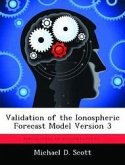The most current version of the Parameterized Real-time Ionospheric Specification Model (PRISM), version 1.7b, was validated using Digital Ionospheric Sounding System (DISS) measurements of F2 layer critical frequency (foF2) and F2 peak electron density height (hmF2) as the "ground truth." PRISM was executed, first, with no real-time input parameter and, second, with Global Positioning System (GPS) Total Electron Content (TEC) measurements as the sole real-time input parameter. Hourly values of hmF2 and foF2 over 123 days in 1994-1996 (solar minimum conditions) and covering three seasons (equinox, summer solstice, and winter solstice) were compared for Wallops Island, Virginia and Point Arguello, California, which both have a GPS receiver and a nearby DISS station. Values of hmF2 and foF2 from the DISS data, the PRISM output with no real-time input parameters, and the PRISM output with the GPS TEC measurements are compared as a function of season and local time. Results indicate PRISM overestimates foF2 by 20-30% when ingesting GPS TEC.
Bitte wählen Sie Ihr Anliegen aus.
Rechnungen
Retourenschein anfordern
Bestellstatus
Storno








